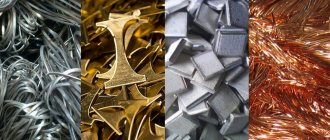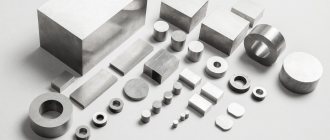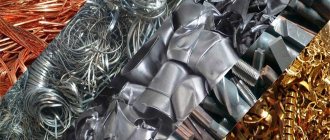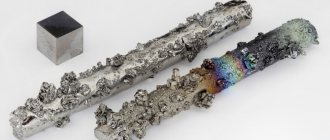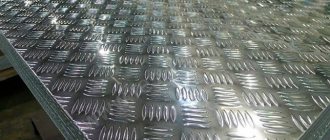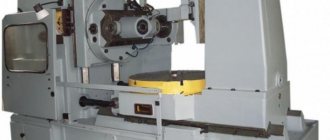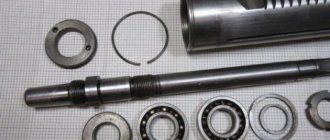Since ancient times, people have tried to use steel for medical purposes. The first experiments did not end very well: it rusted, in some cases causing the death of the patient. But science did not stand still. Metallurgy developed: production and alloying technologies improved, new metals were discovered. As a result, in 1666, a certain Fabricius first successfully performed an operation, fastening the broken sections of the bone with a steel ring. This is how the concept of surgical steel came into use.
Characteristics of medical steel
Medical steel is a group of different grades of metals. The products have an attractive appearance. But this is only a visual characteristic. In terms of density and hardness, medical steel is the best material for medical institutions. It contains the main thing with which the word “medicine” is associated:
- quality;
- sterility.
The cleanliness of an instrument depends on the presence of microscopic cracks and scratches on it, into which dirt and harmful microorganisms can penetrate. And medical or surgical steel:
- does not allow bacteria to enter the structure;
- cleans well;
- does not cause allergies.
In a word, the raw materials are proven and reliable.
Special processing
Medical steels have all the necessary characteristics for their use as tools, devices, and equipment. To reduce brittleness in production, each steel is sometimes “tempered.” The hardness indicator is reduced to 50-52 units. The essence of the process is as follows: parts are heated in a technological furnace to 1050ºС, then sharply cooled in a liquid medium - oil, water or emulsion. After this, the metal is heated again, cooling simply in air.
In this way, especially important instruments are made where plasticity is needed and fragility must be avoided: scissors, clamps, forceps, scalpels. After tempering, all instruments retain good thermal insulation, sparkling appearance, good ductility, and ease of use for a long time. The devices serve for a long period, performing their functions perfectly.
Basic properties of surgical steel
The term "surgical steel" is used by specialists to refer to the material from which medical instruments are made.
It may have a different chemical composition, but it certainly meets the requirements, without which use in surgery becomes impossible.
Mechanical
The main property of the material is hardness. An ultra-thin blade is machined only from a particularly hard alloy. Under increased mechanical load, the tool should not bend, and during a fall or impact on a hard surface, it should not form cracks and chips. Hardness depends on the presence of carbon, which should be 0.4-1.2%.
Silicon (1%), manganese (1%) is introduced into the alloy, which gives the finished products:
- elasticity;
Tool steel is very strong. - wear resistance;
- endurance;
- guarantee a long service life.
Physical
Porosity plays an important role in instrument disinfection.
If it is made of a highly porous alloy, bacteria enter the cavities between the grains of the metal - potential spreaders of infection throughout the human body.
Disinfectants are unable to properly neutralize infected pores. Therefore, surgical steel is made from a low-porosity alloy that can be easily sanitized.
In addition, things made of surgical steel have the following properties:
- waterproof;
- corrosion resistance;
- inertness towards organic tissues;
- do not release toxins.
During processing, alloys do not react chemically with inorganic substances. And one more plus - medical steel does not cause allergies.
Medical steel is hypoallergenic.
Technological
In the production of surgical steel grades, modern technology is used - alloying - adding additives to the iron so that the resulting material exhibits the best properties. Chromium, nickel, molybdenum, manganese - elements of the periodic table affect the quality characteristics of the final material.
Medical instrument steel is hard and resistant.
Price
The cost of a men's bracelet made of surgical steel will be the same, and a sheet of AlSl316L alloy will be different. For source codes they ask from 10 rubles. At the same time, the sheets from the factory differ in thickness. As a rule, they offer samples from 0.1 to 999 millimeters.
The sheets are also damaged when they are cut. For example, 1 by 2 meter plates are offered for 140, 218, 240 rubles. Depends on the manufacturer and the nuances of the alloy formula.
Some sellers set a price tag per kilogram or ton. For example, one of the companies in Nizhny Novgorod sells 1,000 kilograms of 316L steel for 416 rubles. On the jewelry market, this amount can be asked for a bracelet weighing about 30 grams. It all depends on the brand, the complexity of the design, and its compliance with the latest fashion trends.
Regarding jewelry, people most often ask about the cost of piercings. Surgical steel , being in the body, will not cause allergies or other negative consequences. Gold rods can bend, and are not accessible to everyone. As a rule, having made one puncture on the body, people tend to come to the salon again.
It is more profitable to purchase 20 steel jewelry than one precious one. For one barbell made of improved iron you will have to pay only 50-100 rubles. We are talking about 19 mm models without additional elements, for example, stones.
The photo shows a men's bracelet made of surgical steel
Surgical steel remains exotic only among wedding rings. Experts say it's a matter of time. The first samples for weddings have already been released. Newlyweds resort to them because of their special strength.
The wedding ring is worn without taking off. Gold is a soft metal. You have to constantly polish the symbol of love, getting rid of scratches.
Silver rings are covered with niello and do not tolerate moisture. But steel models are the true embodiment of durability and strength of relationships. There is also something sterile in the new trend, indicating the purity of feelings, it’s not for nothing that the alloy is medical.
Composition of alloys for surgical steel
There are many types of processing, but it is the alloying additives that affect the uniqueness. Depending on the added substance, the structure of the material and properties change.
Molybdenum alloy
This material is used to make not only high-quality tools, but also utensils used in medicine. Surface:
- does not scratch;
Tools made of steel with molybdenum. - easy to clean;
- meets hygiene requirements;
- withstands high temperatures and acids.
The molybdenum additive increases the hardenability of the alloy, which significantly improves the strength and durability of products.
Chrome-nickel alloy
The main feature of the compound is called heat resistance, so it is better calcined. This affects the strength and long service life. Steel enriched with chromium and nickel is resistant to oxidation. Items made from chromium-nickel do not rust, so they can easily “work” in an aggressive alkaline environment.
The alloy is used to make tips, working parts of medical instruments, and implants.
Chrome-nickel alloy.
Ferritic chromium alloy
This is a common type of alloy used both in medicine and in other industries. Ideally resists corrosion, thanks to the 14% chromium content. Used for products not intended for heavy loads.
Among others, this material has a relatively low price, since it does not contain nickel.
How to identify a stainless steel product?
Many consumers often try to determine on their own what metal a particular household item is made of. Visually, ordinary steel cannot be distinguished from stainless steel, so it is customary to use a magnet to check. There is an opinion that real anti-corrosion steel is not magnetic. Can stainless steel be magnetic or not? Anything can happen. Therefore, this method of verification does not give a reliable result. Sometimes it happens that a product is attracted to a magnet, but serves for a long time without changing its qualities.
And vice versa, which does not react to it in any way, upon contact with water it becomes covered with rust. Corrosion resistance can be correctly determined by examining its chemical composition, which is impossible to do at home. To protect yourself from counterfeits, it is better to purchase household products in branded stores.
Source
Scope of application
Having a lot of advantages, medsteel is used in various spheres of human activity.
- Medical surgical instruments: forceps, scalpels, clamps have long been part of the daily use of doctors of any specialty. Prostheses that come into contact with living tissue are durable and reliable. A thin syringe needle and high-tech devices for complex operations have one thing in common - they are made of medical steel.
- Non-toxic surgical steel is used in the food industry. Cutlery looks neat and aesthetically pleasing. Some parts of kitchen electrical appliances are cast from medical alloys.
- Mechanical engineering uses alloys for high-strength parts. Insensitive to acetic and lactic acid, they impart wear resistance and abrasiveness to the elements.
- Architects and designers use materials to give buildings and premises a modern, presentable appearance.
- Recently, medical steel has firmly occupied a niche in cosmetology and in the jewelry market. Jewelry wins fans due to its low maintenance requirements and relatively low price. The physical properties are also attractive: steel jewelry is not as scratched as gold, and does not turn black from moisture as much as silver.
Surgical steel.
Where can you buy or sell
You can buy jewelry in large jewelry stores in Moscow or other regions of Russia. They often have departments selling costume jewelry made from alloys with semi-precious stones. Online stores also offer a large assortment of medical gold; you just need to enter a query in a search engine.
The catalogs contain detailed photos, which allows you to choose jewelry without leaving your home. The order can be delivered by courier, transport company or Russian Post.
6 years in jewelry making. Knows everything about samples and can identify a fake in 12 seconds
But if you are not an entrepreneur, you can sell jewelry only through private advertisement sites. Pawnshops rarely take gold-plated items. In the best case, if the coating is significant enough, they give a very small price for it.
Care
Despite the fact that the description of surgical steel states that it is undemanding in care, in order for the products to last longer, some rules still have to be followed:
- Medical instruments, as well as those used in cosmetology, should be protected from contamination. To do this, they must be stored in individual packages or in special boxes. After disinfection, before placing in the sterilizer, rinse with water to remove any remaining “chemicals”. This will prevent the drug from becoming more aggressive when exposed to high temperatures, which causes corrosion. Do not exceed the dosage of the disinfectant solution.
- Jewelry, regardless of composition, also requires attention:
- It is advisable to store each product in a separate container (bag, box);
- Wipe with a polishing cloth 1-2 times a week, removing traces of sebum and dirt;
- Wear gold-plated steel jewelry separately from others to avoid minor scratches.
Costume jewelry is worn after applying cosmetics so that chemicals do not leave traces in the form of stains and grease.
Reviews
Natalya “I decided to check my rings to see if they were gold. The iodine method works, there are traces left on mine. It’s good that I didn’t think of smearing iodine on a cotton swab, but used a thin needle!”
Olga “I’ve met such shops with medical gold. Somehow I didn’t trust it, I was afraid, I thought it was some kind of fake. Now I understand that it is not a fake, but simply something completely different than gold. I’ll have to buy a set for the holiday!”
Irina “I had a bracelet made of medical gold. I wore it for about a year, most often I wore it in winter, in summer I don’t like jewelry on the skin. The lock was wiped first, then the links that were located nearby. The metal itself under the gilding turned out to be dark. But I enjoyed the year.”
What is stainless steel
Stainless steel
– These are iron-based alloys with various impurities. The most common alloying additives are carbon, chromium, nickel, titanium, and niobium. Each of the elements imparts new physical and mechanical properties to the alloy, thereby increasing its strength or increasing its ductility. The main advantage of stainless steel is its resistance to corrosion; it owes this property to chromium, which is present in every stainless alloy. A sufficient amount of this element ensures the anti-corrosion properties of the metal.
The presence of nickel gives the alloy many important qualities: ductility, heat-resistant properties, improves the quality of weldability, and reduces the rate of corrosion. With the acquisition of anti-corrosion properties, stainless steel is not inferior in strength to ordinary steel. Stainless steel retains all the valuable qualities of metals: it is both strong and ductile, and lends itself well to processing: cutting, welding, rolling, stretching, bending. Due to its good performance, stainless steel is used for the manufacture of stainless steel products. All grades of stainless steel are manufactured in accordance with GOST 5632-2014.
Decoding steel markings
Alloy steels are those into which special chemical elements are introduced: nickel, chromium, cobalt, titanium, tungsten. Their addition to the steel composition serves to influence the structure of the metal and obtain improved properties. The marking of steels depends on the chemical composition. At the beginning, numbers are indicated indicating the carbon content in hundredths of a percent (GOST 4543-2016). Next are the letters that indicate alloying elements. In the names of steel and alloy grades, chemical elements are designated by the following letters:
- A (at the beginning of the mark) - sulfur;
- A (in the middle of the mark) - nitrogen;
- B - niobium;
- B - tungsten;
- G - manganese;
- D - copper;
- E - selenium;
- K - cobalt;
- M - molybdenum;
- N - nickel;
- P - phosphorus;
- P - boron;
- C—silicon;
- T - titanium;
- F - vanadium;
- X - chromium;
- C—zirconium;
- Yu - aluminum;
- h - REM (rare earth metals: lanthanum, praseodymium, cerium, etc.).
If the letter A is at the end of the marking, this indicates that the steel is high quality. The letter Ш is placed at the end of the marking for especially high-quality steels.
After the letter there are sometimes numbers indicating the content of the alloying element as a percentage. If there is no number, the content of the element is no more than 1%.
At the beginning of the marking of tool alloy steels, the first place is occupied by a number indicating the average carbon content in average fractions of a percent (GOST 5950-2000). If it is not indicated, then the percentage is 1% or more. Further, the designation of stainless steel coincides with structural steels.
Special-purpose stainless steel grades are marked differently. At the beginning there is a letter indicating the purpose of the steel:
- A – automatic;
- E – electrical;
- Ш – ball bearing;
- R – high-speed.
After that come numbers indicating the average number of the main alloying element.


